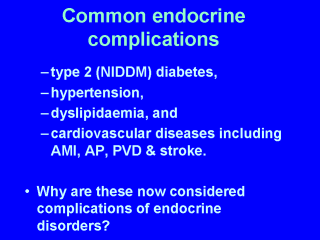 |
The increasing
inactivity and high density diets consumed by people in developing and developed countries
makes them particularly vulnerable to developing type II (formerly called "adult
onset") Diabetes Mellitus (non-insulin dependent DM or NIDDM). How the the phenotype
interacts with the environment (in its broadest sense) determines most chronic disease
(see Barker's hypothesis). A calorie-dense particularly high fat, high refined
carbohydrate diet, together with low levels of activity leads to fat accumulation, which
in turn is associated with dyslipidaemia, insulin resistance, vascular occlusion and
eventual necrotic and other outcomes, (AMI, PVD retinopathy, nephropathy, stroke). The
initial manifestation of these problems is called Syndrome X or Metabolic Syndrome. The
common pathway of these complications is through the production of diffuse vascular
damage, by way of both the rapid development of vascular atheroma and fluctuating serum
glucose levels. In DM, fluctuating blood glucose is a marker for damage to the basement
membrane of the micro-circulation, but not the larger vessels, where atheroma is a more
frequent problem. Obviously then, small blood vessels will be affected first, followed by
larger vessels, and so tissues reliant on micro-vascular support might be expected to be
affected first.
Can you think what tissues are likely to be affected first? |
